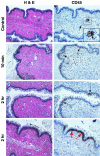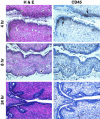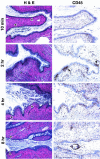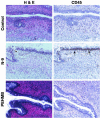Mouse model of cervicovaginal toxicity and inflammation for preclinical evaluation of topical vaginal microbicides
- PMID: 15105142
- PMCID: PMC400576
- DOI: 10.1128/AAC.48.5.1837-1847.2004
Mouse model of cervicovaginal toxicity and inflammation for preclinical evaluation of topical vaginal microbicides
Abstract
Clinical trials evaluating the efficacy of nonoxynol-9 (N-9) as a topical microbicide concluded that N-9 offers no in vivo protection against human immunodeficiency virus type 1 (HIV-1) infection, despite demonstrated in vitro inactivation of HIV-1 by N-9. These trials emphasize the need for better model systems to determine candidate microbicide effectiveness and safety in a preclinical setting. To that end, time-dependent in vitro cytotoxicity, as well as in vivo toxicity and inflammation, associated with N-9 exposure were characterized with the goal of validating a mouse model of microbicide toxicity. In vitro studies using submerged cell cultures indicated that human cervical epithelial cells were inherently more sensitive to N-9-mediated damage than human vaginal epithelial cells. These results correlated with in vivo findings obtained by using Swiss Webster mice in which intravaginal inoculation of 1% N-9 or Conceptrol gel (containing 4% N-9) resulted in selective and acute disruption of the cervical columnar epithelial cells 2 h postapplication accompanied by intense inflammatory infiltrates within the lamina propria. Although damage to the cervical epithelium was apparent out to 8 h postapplication, these tissues resembled control tissue by 24 h postapplication. In contrast, minimal damage and infiltration were associated with both short- and long-term exposure of the vaginal mucosa to either N-9 or Conceptrol. These analyses were extended to examine the relative toxicity of polyethylene hexamethylene biguanide (PEHMB), a polybiguanide compound under evaluation as a candidate topical microbicide. In similar studies, in vivo exposure to 1% PEHMB caused minimal damage and inflammation of the genital mucosa, a finding consistent with the demonstration that PEHMB was >350-fold less cytotoxic than N-9 in vitro. Collectively, these studies highlight the murine model of toxicity as a valuable tool for the preclinical assessment of toxicity and inflammation associated with exposure to candidate topical microbicides.
Figures







References
-
- Achilles, S. L., P. B. Shete, K. J. Whaley, T. R. Moench, and R. A. Cone. 2002. Microbicide efficacy and toxicity tests in a mouse model for vaginal transmission of Chlamydia trachomatis. Sex. Transm. Dis. 29:655-664. - PubMed
-
- Anderson, D. J. 1996. The importance of mucosal immunology to problems in human reproduction. J. Reprod. Immunol. 31:3-19. - PubMed
-
- Anonymous. 2001. The SAS/STAT user guide, version 8, p. 2875-3026. SAS Institute, Inc., Cary, N.C.
-
- Chvapil, M., W. Droegemueller, J. A. Owen, C. D. Eskelson, and K. Betts. 1980. Studies of nonoxynol-9. I. The effect on the vaginas of rabbits and rats. Fertil. Steril. 33:445-450. - PubMed
-
- Fichorova, R. N., and D. J. Anderson. 1999. Differential expression of immunobiological mediators by immortalized human cervical and vaginal epithelial cells. Biol. Reprod. 60:508-514. - PubMed
Publication types
MeSH terms
Substances
Grants and funding
LinkOut - more resources
Full Text Sources
Other Literature Sources
Medical

